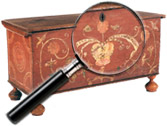|
|
Weegee-Photojournalist (1899-1968)
Born in 1899 in Zlothew near Lemberg, then a part of the Austrian province of Galicia, today part of Ukraine, Weegee’s real name was Usher (later Arthur) Fellig. He was the second of seven children from Jewish parents. In 1903, antisemitic campaigns spread throughout the Russian Pale. Pogroms unseen since the 1880s forced thousand of Jews to emigrate. In 1905 Russian revolutionaries almost succeded to overthrow the Tsar. The Fellig family acted [...] Click here to continue reading.
The Story of Wedgwood & Majolica Pottery
During the second quarter of the 19th century, there was an explosion of interest in matters botanical and horticultural in Europe. The discovery of the process of plant reproduction by the botanist Robert Brown inspired English gardeners to construct greenhouses and fill them with a wonderful array of rare specimens. Minton & Company, one of Britain’s leading ceramic factories, created majolica urns, cachepots, garden seats and other [...] Click here to continue reading.
Wedgwood Carrara Ware
Parian was first marketed in 1846 by the British pottery firm of Copeland as a white porcelain-like body, slightly translucent. Named “Parian” by the Minton pottery, this ware was introduced by Wedgwood in 1848 as “Carrara Ware”. This pottery type has come to be known as Parian generically, regardless of manufactory, and in its pure white form, was used mainly for figures, groups and busts. Wedgwood also made other shapes in [...] Click here to continue reading.
Wedgwood played catch-up to the other Staffordshire potters in the manufacturing of a form of porcelain known as Bone China. Composed of china clay, feldspathic rock and bone ash (calcined animal bone), this porcelain was first introduced in 1799 by Josiah Spode. Bone china was a purer white in color, lighter in weight and less brittle than its oriental and continental European counterparts. Although factories at Chelsea, Derby and Lowestoft had been making a [...] Click here to continue reading.
Josiah Wedgwood & the Wedgwood Pottery
By Paul H. Lauer, New England p4A.com representative
Josiah Wedgwood (1730-1795), with generations of potters behind him and generations to come, finished his apprenticeship and entered into business with one of the best potters of the time, Thomas Whieldon, in the early 1750′s for five years, producing among other things, the green glaze and mottled glaze tableware for which the partnership became known.
In 1768, Wedgwood went into [...] Click here to continue reading.
Charles T. Webber (American, 1825 to 1911)
Charles T. Webber was one of the most influential painters, sculptors and teachers during the Golden Age of Art in Cincinnati in the 19th and early 20th centuries. When Webber’s family moved to Covington, Kentucky in 1858, the artist found work across the river in Cincinnati tinting photographs. Afterward, Webber entered a partnership in a dual photographic/artist’s portrait studio. He was a founding member of the Cincinnati [...] Click here to continue reading.
The History and Manufacture of Weathervanes
Collectors of Americana classify weathervanes as “folk sculpture”, but to the original purchasers, they were meteorological tools that predicted wind direction, and thus a change in the weather. Handmade in the 17th and 18th centuries in America, by the mid-19th century, weathervanes were being factory-produced in large numbers. Both the earlier and later examples are highly collectable, and are sought after for their quirky vitality. Value depends less [...] Click here to continue reading.
Charles Joseph Watelet (Belgian, 1867-1954)
Charles Watelet was a student of J. Portaels and Alfred Stevens. After his debut at the Salon des Artistes Francaise in 1902, when he earned a second class medal, Watelet exhibited frequently; in 1925 he earned a gold medal, and became a non-competing member of the Salon. He was also honored as Chevalier of the Legion d’honneur.
Charles Watelet was particularly drawn to the depiction of women in portraiture, [...] Click here to continue reading.
[...] Click here to continue reading.
Abraham (Abel) George Warshawsky (1883-1962)
A Cleveland area impressionist, Warshawsky left Cleveland for New York in 1905, and then expatriated to Paris. He eventually returned to Cleveland in 1910, and taught there with William Sommer. He exhibited vibrantly colorful impressionist works from the 1910′s to 1940′s, and his work is in the collections of Cleveland Museum of Art, Minneapolis Art Institute, Art Institute of Chicago, and the Luxembourg Museum (Paris).
|
Recent Articles
- Charles Alfred Meurer – American Artist & Tromp L’Oeil Artist
- Sendak, Maurice – American Artist & Writer
- Godie, Lee – American Artist
- Davis, Vestie – American Artist
- Bartlett, Morton – American Artist
- Mackintosh, Dwight – American Artist
- Evans, Minnie Jones – African-American Artist
- Mumma, Ed (Mr. Eddy) – American Artist
- Nice, Don – American Artist
- Savitsky, John (Jack) – American Artist
- Gordon, Harold Theodore (Ted) – American Artist
- Dial, Thornton – African-American Artist
- Doyle Sam – American Artist
- Johnson, Lester Frederick – American Artist
- Finster, Howard – American Artist
|
|
